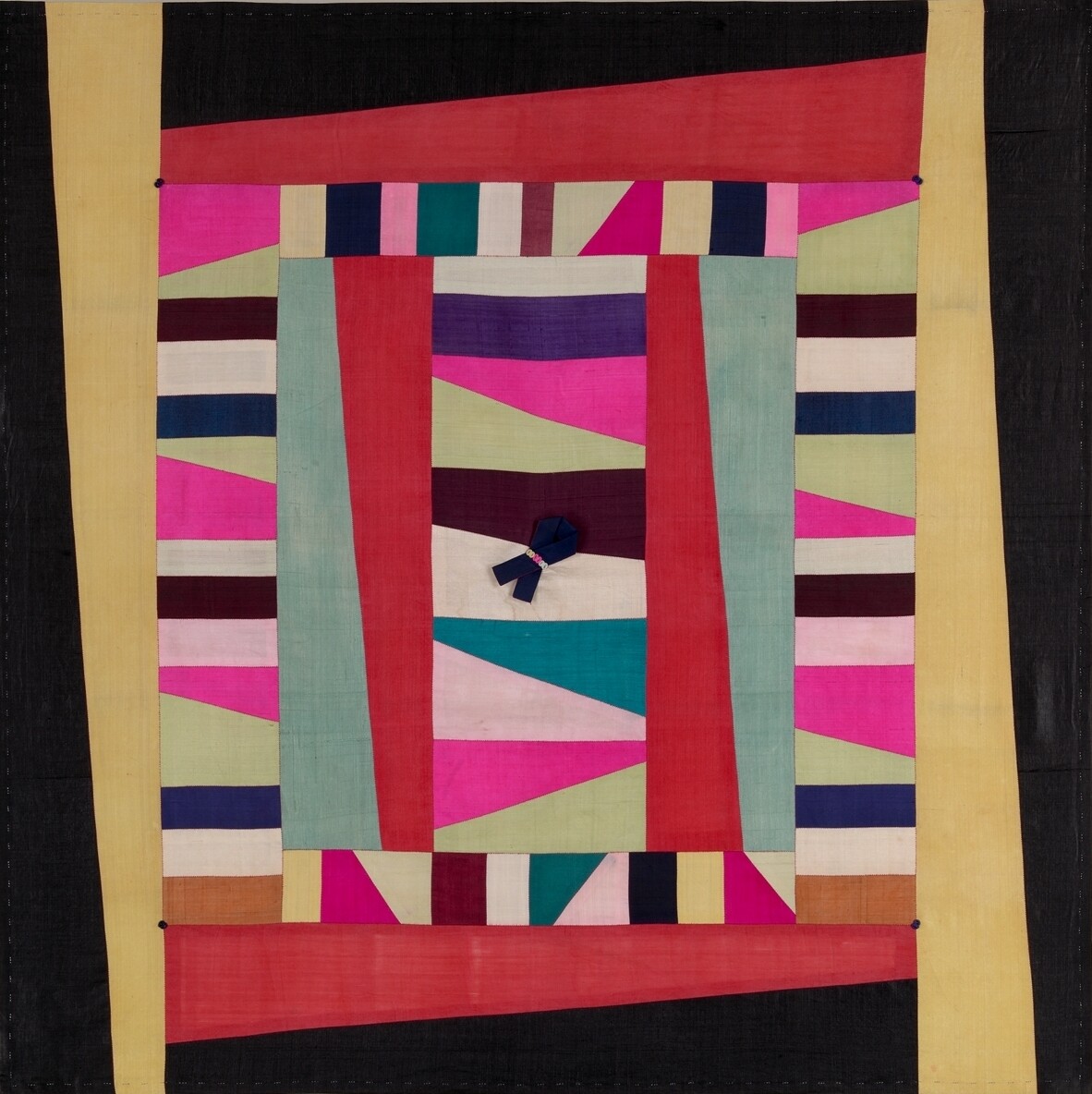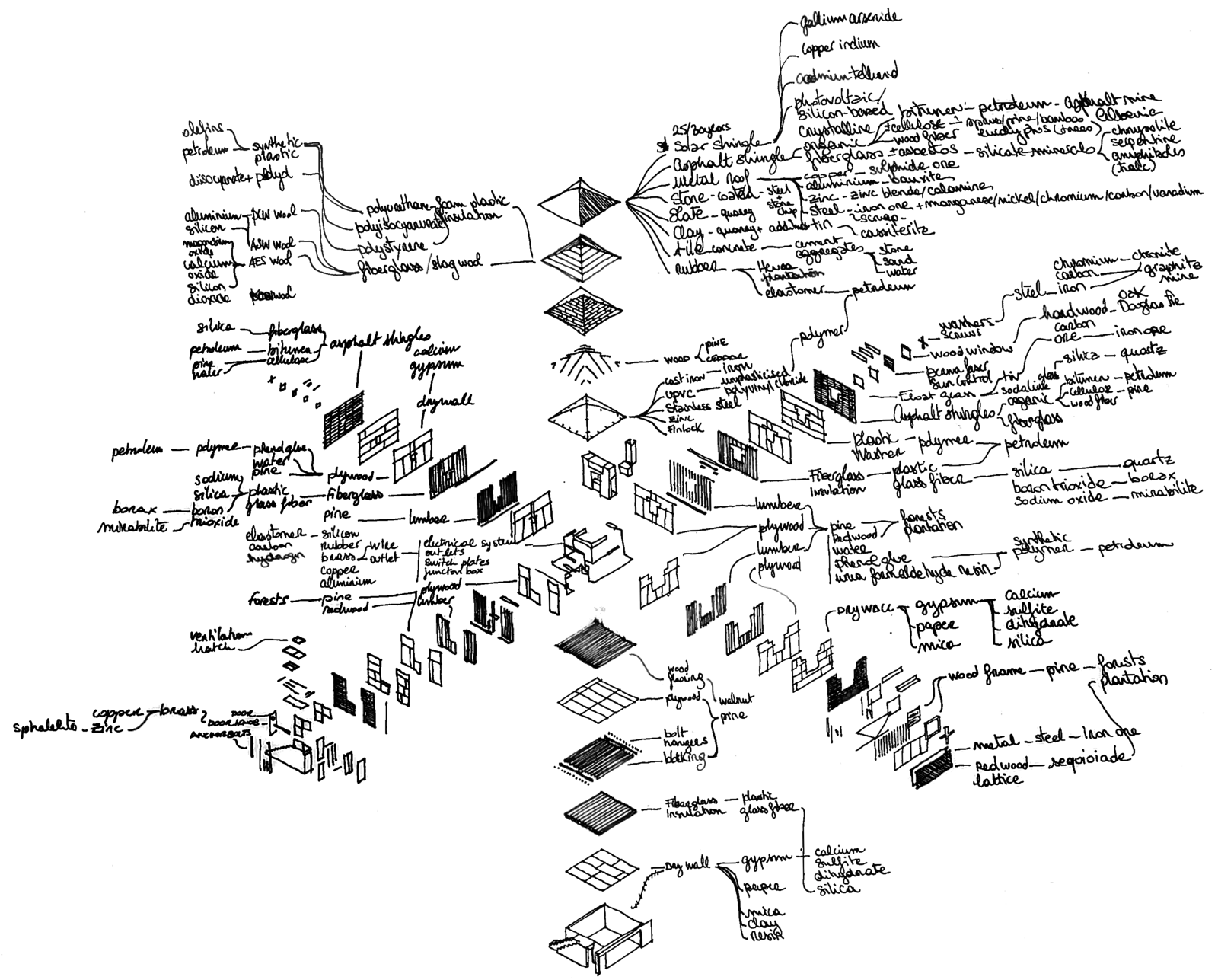To “animate” means, among other things, to give life to inert objects.1 As contemporary biology moves steadily away from the underlying laws that define life in favor of an open field of generative, dynamic collaborations that enliven organic matter, a new theory of materialism has emerged across the disciplines of political science, philosophy, and geography. New materialism proposes that all matter has agency akin to living humans. According to political theorist and philosopher Jane Bennett, this understanding of matter acknowledges “the capacity of things—edibles, commodities, storms, metals—not only to impede or block the will and designs of humans but also to act as quasi agents or forces with trajectories, propensities, or tendencies of their own.”2 From the components of an electrical grid, to the food that living beings consume and through which they are transformed, to the irregular crystalline structure that allows iron to turn into steel when heated, these often-dissonant assemblages of matter act together to impact our human designs for and situations in the world.3
Without stable distinctions between the force of animate and inanimate matter within such assemblages, the act of giving life can be understood to occur through material encounters and possible exchanges between all forms, structures, and systems, both living and nonliving. For Bennett, this transition “from a world of nature versus culture to a heterogeneous monism of vibrant bodies” recognizes that organic and inorganic material cannot be held so far apart, cannot be completely fixed, bounded, or contained: all are energetic tendencies that transform by way of each other.4 The quantum physicist and feminist theorist Karen Barad affirms the entanglement of materiality, noting that “independent objects are abstract notions.”5 Instead, objects emerge through their relationships with other things, rather than existing prior to them. These relationships momentarily sediment matter into objects, yet also offer the possibility of reconfiguring those forms through material processes of exchange: one thing can become another.
Alongside a new materialist conception of agentic matter, performance theory brings embodied context and duration to the formation of things in space, and calls attention to the larger environmental and temporal conditions that make any object, interaction, or exchange possible. As such, in tandem with the give and take of vibrant assemblages that make up each form, dynamic specificities such as ground, climate, atmosphere, and the particularities of our bodies enliven and are enlivened by encounters occurring in real time and situated in a particular site. Within performance theory, the differentiation between performance and performativity is key to understanding the ways in which forms are iterated and sustained across time, as well as the moments and sites in which transformations are possible. The philosopher J. L. Austin defines performative speech acts as statements that enact something as they are being uttered, like the “I do” of a wedding.6 The action of joining two people together in marriage occurs through the repetition of this vow over time, and because all parties giving and receiving these words have similar expectations every time they are spoken.
At work around the repetitive framing of performativity, performance refers to the variable embodiment of these iterations, and to the number of ways that performativity’s promise to enact the same thing, again and again, can (and often does) go wrong. This leads to the potential for revision or transformation beyond reiteration.7 As performance theorist Peggy Phelan argues: “In moving from the grammar of words to the grammar of the body, one moves from the realm of metaphor to the realm of metonymy.”8 For Phelan, bodies perform metonymically because they can deflect and displace meaning through each unfolding of embodied action. To follow Phelan beyond the specifically human body, material objects also perform in relation to each other, resisting stable replicability and predictability. To move from the performativity of material form to its performance is to reinvest in contextual variabilities and relational dependencies across varying scales and sites and to recognize the capacity for material change. It is to affirm the multi-directional agency of entangled matter activated between you and I, this surface and that volume, today and tomorrow.
Proposing that all matter has life-like agency not only means that matter acts and responds, but that it does so on its own, outside of any human-controlled performative program, and with goals that we can only seek to predict. The material performances that occur in the spaces, bodies, and timings of an encounter between things and beings, and that offer the capacity for transformation, may suggest a spontaneous intelligence that is separate from ours. With their own agency, formations of matter challenge us to imagine beyond repetitive performative actions and expected responses, and to remain open to variable and indeterminable assemblages that change over time with purposes distinct from ours. These intersections of material actors decenter human plans with propositions of their own. Unsettling boundaries between living and nonliving forms destabilizes qualifications for intelligent life.
Artificial intelligence and its capacity for machine learning claim the ability to act like living humans and do more than us computationally. AI is generally performative: we feed it large quantities of data, and it sorts, filters, recombines, and feeds it back to us.9 Although much faster and comprehensive than we are, as Lauren M. E. Goodland explains, “the machine ‘learning’ in question (in contrast to the generalizable experiential learning of humans) involves programmed instructions to update statistical weights in order to optimize predictions about specific data-driven tasks or domains.”10 While AI is built on a perceived alignment of functionality between computers and our brains, Goodland argues that it tends to ignore “more complex and situated perspectives (including the impact of physical embodiment, emotions, webs of relationality, relations of care, cultural contexts, and/or philosophical assumptions).”11 Often negated by AI’s iterative performativity, these multi-dimensional entanglements foreground the histories and relational conditions of material performances over time, and propose a more expansive qualification of intelligence in humans and non-humans alike.
In 2023, a group of scientists and engineers coined the term “organoid intelligence” to describe nascent research into the response of 3D cultures of brain cells to external stimuli, starting with the premise that biological neural networks learn, adapt, and evolve in ways that artificial networks do not.12 A decade earlier, however, the artist Guy Ben-Ary and his interdisciplinary team of collaborators were already growing living brain tissue that could interact with other material forms and bodies, identifying this capacity for unprogrammed decision-making as “in-vitro intelligence.”13 In 2013, Ben-Ary sent his own skin cells to scientists at the University of Barcelona, where they were reverse-engineered into human embryonic stem cells and then differentiated into neurons by his team in Perth.14 Making its debut in October 2015, cellF is a functioning neural network that is actualized through encounters with other forms, forces, and energies. The petri dishes that host Ben-Ary’s firing neurons contain a grid of electrodes that is capable of both recording the neurons’ signals as well as stimulating them in a performative feedback loop. Music from live musicians is sent to the neurons as electrical stimulation and the neurons respond through electrical impulses. Those responses are then amplified and sent to a synthesizer, creating an improvised sound assemblage that differs in each iteration and is dependent on location, timing, and audience, as well as the specificities of cellular and human performers. These neurons, electrodes, musicians, instruments, and their combined electrical impulses and soundwaves act with and against each other, as the changing confluence of object and subject, and living and nonliving matter, in each specific environment, unpredictably alters the shape and direction of every performance.
The materiality of cellF’s living neurons exists two-dimensionally, but it is also possible to grow three-dimensional neuronal networks (“cerebral organoids”) that are structured like the intricate folded forms of our brains, and thus may offer more complex and intelligent functionality over time. With 3D brains, longer-term learning, adapting, and evolving with and against external stimuli becomes possible.15 Since 2020, Ben-Ary, Nathan Thompson, and Stuart Hodgetts have been exploring the growth of cerebral organoids from blood cells taken from minimalist composer Alvin Lucier.16 In October 2023, two years after Lucier died, Ben-Ary, Thompson, and Andrew Fitch, along with Hodgetts and Darren Moore, premiered Music for Surrogate Performer, a performance in which Lucier’s brain tissue, grown postmortem over another interface of electrodes, plays percussive instruments.17 This assemblage of animate and inanimate materials, along with embodied and disembodied forms, exchanges energy in the form of electrochemical signals measured in microvolts. The force and direction of this performance, improvised in real time without a preconceived program, is animated not by way of any embodied human or even solely by the living network of neurons suspended in time, but rather from the shifting entangled state of each material form interacting with others for around forty-five minutes. In their next work, Revivification, the neuronal impulses of Lucier’s 3D cerebral organoid will acoustically resonate with tuned metal plates while viewers move within the installation space.18 Ben-Ary aims for this project to be a permanent installation in order to highlight the long duration and capabilities of the organoid as it is being transformed by the metal, cells, bodies, vibrations, and movements on site. This expanded temporality can activate the potential for brain-based intelligent learning through an ongoing performance that is continuously adapting to past encounters and projecting towards future ones.
While the renewability of stem cells may make them the ideal performative iteration of cellular life out of time and context, even stem cells are haunted by their previous material existences and transformed by their interactions with other beings and things.19 This process of feedback, or the call and response of animated agentic matter, can lead towards more sustained material resonances where the effects of their interactions palpably shapeshift, as the boundaries between subjects and objects become more ambiguous and change by way of each other. Indeed, material form is animated across multiple sites of contact and moments of exchange; the impact of heterogenous things resonating together offers the capacity for evolution towards unknown ends. We can imagine this understanding of animated life in terms of sound—with its seemingly intangible, immaterial, yet transformable force—through Ben-Ary’s series of performances. But we can also consider what this means for the ways that we seek to sediment things in the world through design. If we see all matter as agential, potentially intelligent counterparts that animate us as we animate it, we might rethink how we assemble, situate, and engage with objects and structures as our material partners. We might also see our designed forms as propositions of material convergence, rather than as conclusions, where both the possibilities and vulnerabilities of life are distributed beyond the times, scales, and sites of our living bodies.
Merriam Webster, s.v. “Animate (transitive verb), 2a,” ➝.
Jane Bennett, Vibrant Matter: A Political Ecology of Things (Durham, NC: Duke University Press, 2010), viii. See also: Diana Coole and Samatha Frost, “Introducing the New Materialism,” New Materialisms: Ontology, Agency, and Politics, ed. Coole and Frost (Durham, NC: Duke University Press, 2010).
For more on electricity, food, and metals, see Bennett, Vibrant Matter, 25, 39, 59.
Bennett, Vibrant Matter, 121. Mel Y. Chen also considers “how matter that is considered insensate, immobile, deathly, or otherwise ‘wrong’ animates cultural life in important ways” in Mel Y. Chen, Animacies: Biopolitics, Racial Mattering, and Queer Affect (Durham, NC: Duke University Press, 2012), 2.
Karen Barad, “Matter feels, converses, suffers, desires, yearns, and remembers: Interview with Karen Barad,” New Materialisms: Interviews and Cartographies, ed. Rich Dolphijn and Iris van der Tuin (Ann Arbor, MI: Open Humanities Press, 2012) 61. See also: Karen Barad, Meeting the Universe Halfway: Quantum Physics and the Entanglement of Matter and Meaning (Durham, NC: Duke University Press, 2007).
J. L. Austin, How To Do Things With Words (Cambridge, MA: Harvard University Press, 1962), 5-6.
For more about performative slippages, see: Jacques Derrida, “Signature Event Context,” Margins of Philosophy, trans. Alan Bass (Chicago: University of Chicago Press, 1982), 307-330.
Peggy Phelan, Unmarked: The Politics of Performance (London: Routledge, 1993), 150.
AI can and does “hallucinate” and misfire in a way parallel to Austin’s performatives. See: Katherine Lee, Orhan Firat, Ashish Agarwal, Clara Fannjiang, and David Sussillo, “Hallucations in Neural Machine Translation,” Conference on Neural Information Processing Systems (NeurIPS) 2018, Montreal, Canada, ➝.
Lauren M. E. Goodland, “Editor’s Introduction: Humanities in the Loop,” Critical AI 1, no. 1-2 (October 2003).
Goodland, “Editor’s Introduction,” 2. See also: Terrance J Sejnowski, The Deep Learning Revolution (Cambridge, MA: MIT Press, 2018), xi.
Lena Smirnova et al., “Organoid intelligence (OI): the new frontier in biocomputing and intelligence-in-a-dish,” Frontiers in Science 1 (February 28, 2023); also, Cortical Labs in Melbourne is working on a neurobiological platform, “DishBrain,” that can run very basic programs. They’ve already had a 2D layer of 800,000 neurons learn to play the video game Pong. See: Dan Robitzski, “How Neurons in a Dish Learned to Play Pong,” The Scientist, October 12, 2022, ➝.
cellF was developed by Ben-Ary in collaboration with artist Nathan Thompson, electrical engineer Andrew Fitch, scientists Stuart Hodgetts, Mike Edel and Douglas Bakkum, and musician Darren Moore. Vahri Mckenzie, Nathan John Thompson, Darren Moore, Guy Ben-Ary, “cellF: Surrogate Musicianship as a manifestation of in-vitro intelligence,” Handbook of Artificial Intelligence for Music, ed. Eduardo Reck Miranda (Switzerland: Springer, 2021), 915-932.
The majority of embryonic stem cell lines have historically been cultured from surplus in-vitro fertilized embryos that will no longer be implanted. Now we can generate pluripotency, or the capacity of stem cells to develop into any adult cell. In 2006, Shinya Yamanaka discovered that he could reprogram mouse skin cells to act like embryonic stem cells, causing those cells to revert to a prior, nascent state. Like embryonic stem cells, these “induced pluripotent stem cells,” or iPS cells, can self-renew and differentiate into all adult cell types. See: Kazutoshi Takahashi and Shinya Yamanaka, “Induction of Pluripotent Stem Cells from Mouse Embryonic and Adult Fibroblast Cultures by Defined Factors,” Cell 126 (August 2006): 663–676.
Similarly developed from reverse-engineered stem cells, organoids are very small, 3D cell cultures that structurally self-organize and differentiate into specific organ tissues. Within a rotating bioreactor that simulates gravity, these mini-organs can self-assemble up to 5-millimeters in width and, to date, scientists have grown mini-brains, kidneys, lungs, intestines, stomachs, and livers. J. Kim, B.K. Koo and J.A. Knoblich, “Human organoids: model systems for human biology and medicine,” Nature Reviews Molecular Cell Biology 21 (2020): 571–584. To achieve three-dimensionality as well as complex cellular development and function, scientists embed pluripotent cells in an extracellular matrix, which is the structural support that all cells have. This matrix serves as the microenvironment that supports 3D tissue growth.
When Lucier died, in December 2021, his “mini-brains” (cerebral organoids) were alive and his family agreed that the project should continue.
In similar manner to his foundational 1965 performance Music for Solo Performer. Alvin Lucier, “Musik for soloist/Music for Solo Performer,” Fylkingen Bulletin: International Edition, Art and Technology II2 (1967): 16-17. See also: Guy Ben-Ary, Nathan Thompson, Stuart Hodgetts, and Andrew Fitch, Music for Surrogate Performer (2023), Venice Biennale, ➝.
Personal conversation with Ben-Ary, Thompson, and Hodgetts (January 18, 2022).
As medical anthropologist Linda Hogle makes clear: “Human embryonic stem cells are elusive, recalcitrant entities that resist characterization and standardization” with their “distinct, cumulative identities” that change according to the specific lab environments in which they are grown. See: Linda F. Hogle, “Characterizing Human Embryonic Stem Cells: Biological and Social Markers of Identity,” Medical Anthropology Quarterly 24, no. 4 (December 2010): 433.
Material Acts is a collaboration between e-flux Architecture and Craft Contemporary within the context of the eponymous exhibition, curated by Kate Yeh Chiu and Jia Yi Gu as part of Getty PST ART: Art & Science Collide.











